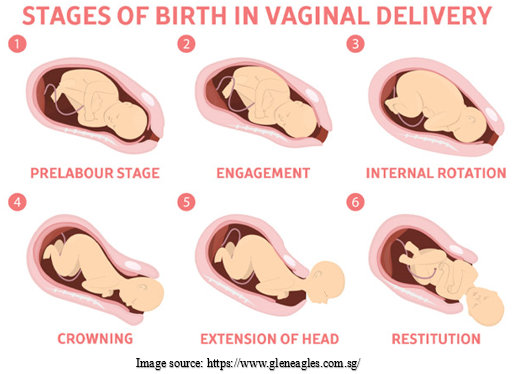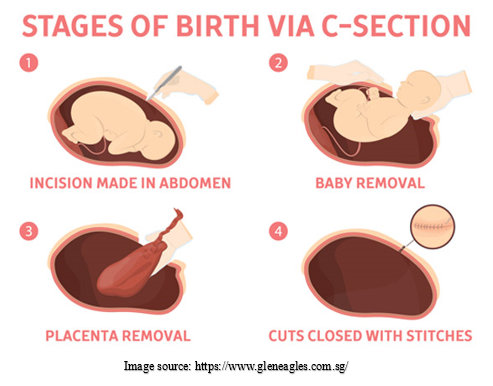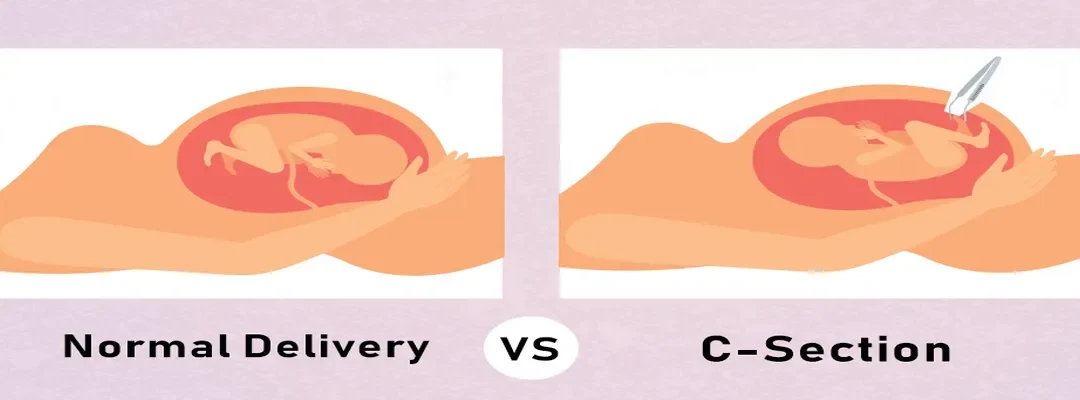One of a mother’s greatest joys is a safe delivery. Babies can be born naturally through vaginal birth or surgically through a cesarean section. Both approaches ultimately aim to protect the mother and child’s health.
According to WHO, only 10% to 15% of births are performed via C-section for the best outcomes for mothers and newborns. Even though there is no real need, 1 in 5 Indian women have C-sections. Doctors often recommend C-sections for women with high blood pressure, obesity, or a ruptured uterus.
Normal delivery is a natural process in which the baby is delivered via the vaginal route. It is a continuous process of cervix dilatation and effacement accompanied by foetal head descent. In comparison, a cesarean section involves an incision in the uterine wall, muscles, and skin to deliver a healthy foetus.
Most mothers and gynecologists prefer normal or vaginal delivery unless there is a complication. The C-section is chosen in that situation.
Dr. Shweta Shah, one of the best gynecologist doctor in Mumbai, has over ten years of experience performing normal and C-section deliveries. She intends to deliver the baby safely through normal delivery in Malad. Besides, she conducts cesarean deliveries in Malad, Mumbai, only when the mother’s and baby’s health is at risk by normal delivery.
The mother’s physical and emotional health, hormone levels, the baby’s position, any last-minute complications, blood loss, placental positioning, etc., are some factors that can affect the mother’s choice of delivery method.
No matter the procedure, a healthy baby and a safe delivery for the mother are always the main priorities. However, if you are expecting or someone in your family is, it is wise to develop a comparative understanding of both approaches.
Women should be as knowledgeable as possible about their childbirth options, regardless of how they give birth, to have a voice in the process, advocate for what they want, and make the best decision.
Here is more information on the benefits and risks of the two childbirth methods.

Normal/Vaginal Delivery
- Normal delivery is the most preferred and secure method of giving birth. This is because no bodily incisions or scars are involved, reducing the risks of complications.
- However, if a woman has a medical condition such as diabetes, high blood pressure, etc., an infection that could harm her unborn child, such as HIV or herpes, or has low placenta volume, she cannot choose normal delivery.
- According to Dr. Shweta Shah, a proficient gynecologist doctor in Mumbai, normal delivery can also be difficult if the mother is carrying a large baby with a small pelvis, having twins or multiples, or if the baby is not in the proper position.
Now, let’s know,
Benefits and Risks of Normal/Vaginal Delivery
Benefits
- The body and the baby naturally prepare for vaginal delivery since it is a non-surgical method of giving birth and progress throughout the gestation period.
- Compared to a C-section, a normal delivery has a shorter post-delivery hospital stay, typically two to three days.
- The muscles force out the amniotic fluid in the baby’s lungs as it passes through the vaginal opening, preventing breathing difficulties for the newborn.
- During this stage, the baby naturally ingests good bacteria that safeguard the intestines and naturally strengthen the immune system.
- Since there is no surgery or anesthesia, the recovery is quick. As a result, it enables the mother to start breastfeeding soon after giving birth.
Risks
- Normal deliveries make it impossible to plan the birth schedule, which can put much pressure on the mother during labor.
- Due to the excessive stretching and tearing of skin and tissue that occurs when the foetus passes through the vaginal canal, the pelvic muscles may become weaker or injured.
- In rare cases, excessive tissue damage raises the risk of incontinence, which is the total loss of bladder and bowel control. Urine may come out while coughing and sneezing as a result. Even the recovery from this takes a few months to a year. In this case, vaginal exercises are helpful.
- The risk of sexual discomfort and pain following a normal delivery may increase.
- In the region between the vagina and the anus known as the perineum, some women may experience chronic pain.
C-Section/Caesarean Delivery

- C-section is a surgical procedure involving an incision through the uterus and abdominal wall. This procedure is slowly gaining popularity because it allows women to schedule their deliveries in advance.
- Women who prefer less painful labor also choose it. However, if a pregnant woman experiences medical issues, a C-section is always the best option for delivery.
- When attempting to turn the baby down but failing, it is also chosen when the infant is not in a heads-down position. When the health of the mother, the baby, or both is at risk, a C-section delivery is the safest option.
Let’s discuss,
Benefits and Risks of C-Section/Caesarean Delivery
Benefits
- Due to the ability to mentally prepare and plan well before the labor, a C-section delivery lessens the woman’s stress and anxiety during childbirth.
- Since the baby is delivered through the uterus and not the birth canal, urinary incontinence is less likely.
- There is less chance of trauma or injury to the baby during delivery due to the minimal use of forceps.
Risks
- Compared to a natural delivery, a woman with a cesarean section typically stays in the hospital for an additional 2-4 days after giving birth.
- There is a high chance of suffering from pain and infection at the incision site, which may lead to soreness that lasts longer.
- C-sections may result in significant blood loss and the development of blood clots because it is a surgical procedure.
- A woman is more likely to deliver future babies via C-section after having one.
- Due to their previous C-section, she is susceptible to pregnancy complications.
A woman must be aware of all the benefits and drawbacks of delivery, regardless of the method of childbirth she chooses. If there is a choice, it is best to express one’s opinions about a delivery process so that the best option can be selected for safe delivery.

